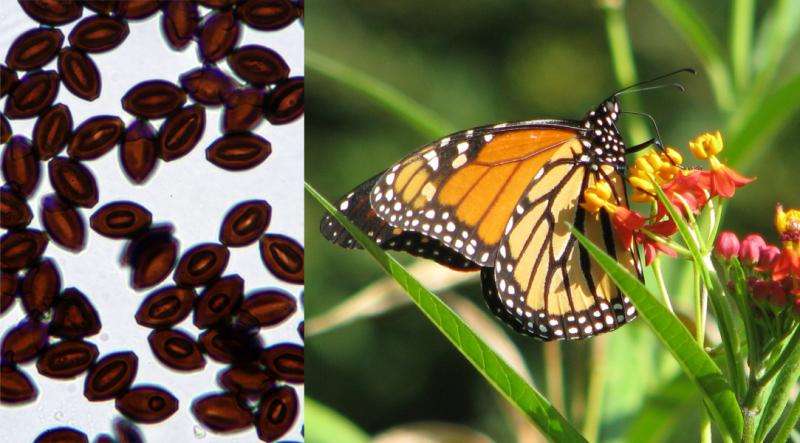Seasonal monarch butterfly migrations may help lower infection levels

Seasonal migrations may help lower infection levels in wild North American monarch butterfly populations, according to a study published November 25, 2015 in the open-access journal PLOS ONE by Sonia Altizer from the University of Georgia, and colleagues.
Long-distance migration can lower parasite prevalence if strenuous journeys remove infected animals from wild populations. The authors of this study examined wild monarch butterflies to investigate the potential impact of the protozoan parasite Ophryocystis elektroscirrha on migratory success. The researchers collected monarchs from two wintering sites in central Mexico to compare infection status with hydrogen isotope measurements, an indicator of latitude of origin at the start of fall migration.
On average, uninfected monarchs had lower hydrogen isotope values than parasitized butterflies, indicating that uninfected butterflies originated from more northerly latitudes and travelled farther distances to reach Mexico. Within the infected butterflies, monarchs with higher levels of infection originated from more southerly latitudes, indicating that heavily infected monarchs originating from farther north were less likely to reach Mexico. The authors used observations of infection levels during the breeding season to show that southerly latitudes did not simply generate more infected monarchs prior to the start of the migration.
Collectively, these results emphasize that seasonal migrations may help lower infection levels in wild animal populations. The authors posit that these results combined with recent observations of sedentary, winter-breeding monarch populations in the southern U.S. indicate that the shifts from migratory to sedentary behavior may lead to greater infection for North American monarchs.
Dr. Altizer added, "The chemical markers allowed us to estimate where the monarchs started and how far they travelled to reach the wintering sites in Mexico, something that would not be possible using other currently available methods. We also found that monarchs with larger wings migrated farther distances on average than those with smaller wings, something that's supported by cross-population comparisons but hasn't been previously shown within North American migratory monarchs."
More information: Altizer S, Hobson KA, Davis AK, De Roode JC, Wassenaar LI (2015) Do Healthy Monarchs Migrate Farther? Tracking Natal Origins of Parasitized vs. Uninfected Monarch Butterflies Overwintering in Mexico. PLoS ONE 10(11): e0141371. DOI: 10.1371/journal.pone.0141371
Journal information: PLoS ONE
Provided by Public Library of Science

















